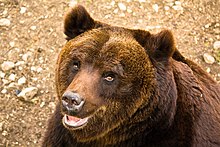Marsican brown bear
| Marsican brown bear | |
|---|---|

| |
| Scientific classification | |
| Kingdom: | |
| Phylum: | |
| Class: | |
| Order: | |
| Family: | |
| Genus: | |
| Species: | |
| Subspecies: | U. a. marsicanus
|
| Trinomial name | |
| Ursus arctos marsicanus Altobello, 1921
| |
The Marsican brown bear (Ursus arctos marsicanus), also known as the Apennine brown bear, is a critically endangered subspecies of the brown bear, with a range restricted to the Abruzzo National Park, and the surrounding region in Italy. Debate exists as to whether should be considered a subspecies or a taxon of its own.[2]
Range and conservation status
The Apennine brown bears range is a small isolated population located within Italy's Abruzzo, Lazio and Molise National Park and in the peripheral locations: Sibillini National Park, Gran Sasso-Laga National Park, Majella National Park, Velino-Sirente National Park, and Simbruini Regional Park.[3] The population range has significantly reduced over the past 200 years and the remaining population is under threat, particularly from the shift from local agriculture to development in Abruzzo, as well as poaching[4] and poisoning.[5] This has led to a current population size estimated at between 40 to 50 bears living in their respective range.[6]
Biology
The male Marsican bears can weigh up to 200 kg (440 lb), with an upright height of 1.9 to 2 metres (6 ft 3 in to 6 ft 7 in), while females are typically smaller.[2] They are among the largest carnivores in Italy.[citation needed] The bears are usually very shy, and often only appear at night. Most of the bears are solitary and occupy their own territory, which can be up to 200 square kilometres (77 sq mi). The bears are sometimes known to enter residential areas in search for food, leading to some conflict with the local population. During the winter, they dig a burrow or stay in a cavity in a rock to hibernate, where, as with most species of bear, they exploit their large fat deposits (gained through eating a lot through the summer and autumn) to survive.[citation needed]
Alimentation
Up to 90% of their diet is made up of vegetation, particularly on roots, tubers, fruits, and berries. Such a diet contains few nutrients, meaning they must eat a lot to survive. However, Marsicans are omnivores, and will kill and eat small animals, or eat the carcasses of larger dead animals. They are seen by many people as a threat, particularly due to the idea that they kill livestock such as cattle; in reality, the bears avoid human contact wherever possible. However, this has led to many people killing the Marsican brown bears due to fear of attack.
See also
References
- ^ Template:IUCN
- ^ a b Loy, A.; P. Genov; M. Galfoc; M. G. Jacobonec; A. Vigna Tagliantic (2008), "Cranial morphometrics of the Apennine brown bear (Ursus arctos marsicanus) and preliminary notes on the relationships with other southern European populations", Italian Journal of Zoology, 75 (1): 67–75, doi:10.1080/11250000701689857
- ^ Paolo Ciucci; Luigi Boitani, "The Apennine Brown Bear: A Critical Review of Its Status and Conservation Problems", Ursus, 19: 130–145, doi:10.2192/07per012.1
{{citation}}: Unknown parameter|last-author-amp=ignored (|name-list-style=suggested) (help) - ^ Hooper, John (2004-08-24). "Italy battles to save the last of its wild bears". The Guardian. Retrieved 2007-08-16. [dead link]
- ^ "Marsican bear found dead in Abruzzo". Italy Magazine. 2008-05-12. Retrieved 2007-06-20.
- ^ Alessandra Falcucci; et al. (2008), "Land-Cover Change and the Future of the Apennine Brown Bear: A Perspective from the Past", Journal of Mammalogy, 89 (2): 1502–1511
Further reading
- Loy, A.; P. Genov; M. Galfoc; M. G. Jacobonec; A. Vigna Tagliantic (2008). "Cranial morphometrics of the Apennine brown bear (Ursus arctos marsicanus) and preliminary notes on the relationships with other southern European populations". Italian Journal of Zoology. 75 (1): 67–75. doi:10.1080/11250000701689857.

